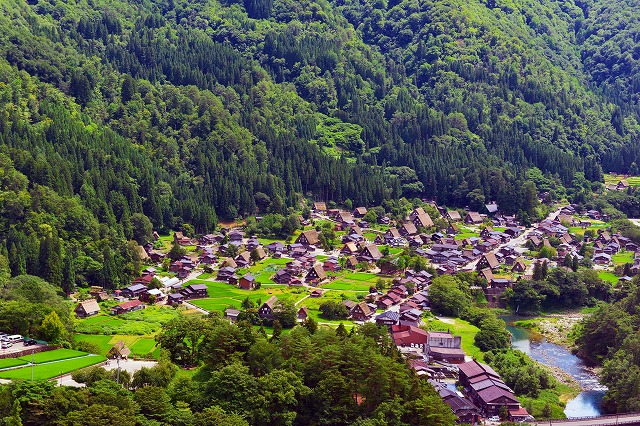最終更新日:2023年12月14日

Ogimachi Historic District
The historic village of Ogimachi occupies a flat, crescent-shaped terrace on the east bank of the Sho River, which flows north toward the Sea of Japan through a long, narrow valley surrounded by mountains. The largest settlement in the Shirakawa-go area, the village is home to more than 100 families, many of whom live in traditional thatched farmhouses built in the gassho or “praying hands” style. The word refers to how the shape of the steeply slanted triangular roofs resembles two hands pressed together in prayer.
This type of house is distinctive to the Sho river valley and was developed during the mid-Edo period (1603–1867) in response to the area’s environment, climate, and industries. The slant of the roof prevents the heavy snowfall that covers Shirakawa-go every winter from accumulating and damaging the house. The walls on the gable ends have large windows to let sunlight and air into the multi-level attic, which was traditionally used mainly for raising silk worms.
The historical value of the gassho-style buildings began to be recognized in the 1970s, when local residents concerned about industrialization and hydroelectric dam construction along the Sho River initiated efforts to preserve the houses for posterity. Ogimachi was designated a Preservation District for Groups of Traditional Buildings in 1976, and a World Heritage Site in 1995, when its townscape and traditional construction practices were added to the UNESCO catalogue as part of the “Historic Villages of Shirakawa-go and Gokayama – Traditional Houses in the Gassho Style” designation.
Shirakawa-mura Ogimachi Natural Environment Preservation Society
The village of Ogimachi became a World Heritage Site in 1995, when it was added to the UNESCO catalogue as part of the “Historic Villages of Shirakawa-go and Gokayama – Traditional Houses in the Gassho Style” designation. This decision marked the culmination of decades of local efforts to preserve the traditional character of the village. In the years after World War II, when more and more electricity was needed to power the rapidly growing Japanese economy, several dams were constructed along the Sho River. These projects brought prosperity to Shirakawa-go, but were also seen as a threat to the local landscape and established lifestyles. By 1971, the number of gassho-style houses in Ogimachi had been reduced by half.
In the same year, the residents of Ogimachi founded the Shirakawa-mura Ogimachi Natural Environment Preservation Society to protect the gassho-style houses and the local community. The Society adopted guidelines that prohibited the sale, renting, and demolishing of gassho-style houses, which were declared a valuable historic and tourism resource. These efforts paid off, first in the form of Ogimachi’s designation as a Preservation District for Groups of Traditional Buildings in 1976 and, two decades later, in the World Heritage inscription. All residents of Ogimachi are members of the Society, which holds monthly meetings to consider applications for changes to gassho-style houses or their surroundings. The Society’s opinion informs the municipal government’s decision to approve or decline such applications.
この英文解説は、2021年観光庁「地域観光資源の多言語解説整備支援事業」により整備しています。
This English description is provided by the "Multilingual Commentary Project 2020" of Japan Tourism Agency.

Back Home